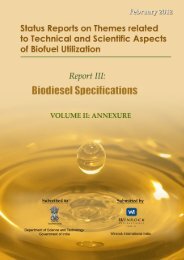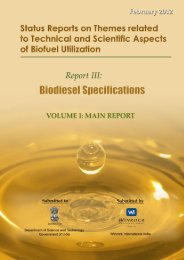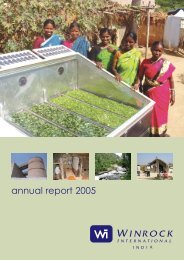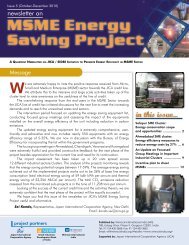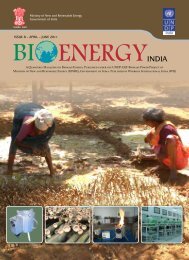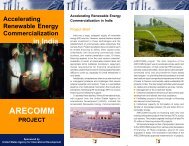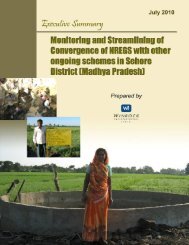ACT Apr-Jun10.p65 - Petroleum Conservation Research Association
ACT Apr-Jun10.p65 - Petroleum Conservation Research Association
ACT Apr-Jun10.p65 - Petroleum Conservation Research Association
Create successful ePaper yourself
Turn your PDF publications into a flip-book with our unique Google optimized e-Paper software.
esources after removing the material and<br />
process related shortcomings in the existing<br />
pot making process. Three different pot<br />
material compositions were identified for<br />
making of improved as well as control test<br />
pots based on various varieties of clay and<br />
grog. The trial and testing activity of the<br />
pots was carried out at the glass processing<br />
unit (bangle making) of M/s Navjeevan<br />
Glass Industries.<br />
The following pictures show the pot<br />
replacement process in the running pot<br />
furnace at M/s Navjeevan Glass Industries.<br />
Achievement and impact<br />
generated<br />
The most important and easily identifiable<br />
indicator of the successful implementation<br />
of activities is the increase in pot life inside<br />
the pot furnace.The outcome of the testing<br />
activity have been highly rewarding in terms<br />
of increase in pot life by more than twice<br />
of the existing average pot life and more<br />
than thrice of the control case provided for<br />
the experiment. The pot life has increased<br />
from the control case of 10 days to the<br />
best result of 31 days and the average pot<br />
life established for processing the red colour<br />
glass now stands at 15 days. It was reported<br />
by the plant management at M/s Navjeevan<br />
Glass Industries that such successful<br />
intervention and improvement in the pot<br />
life has been possible for the first time in<br />
the history of Firozabad glass processing<br />
units. The achievement becomes more<br />
significant and meaningful when seen in the<br />
light of usage of only locally available<br />
materials, workmanship and resources<br />
which can be accessed, implemented and<br />
adopted by the pot maker community from<br />
within their affordable resources.<br />
The improvement in pot life has not only<br />
reduced the monetary losses associated<br />
with frequent pot replacements rather it has<br />
Taking out damaged pot from running pot furnace and transferring new pot inside the<br />
furnace<br />
also made significant impacts on several<br />
issues such as:<br />
● Reduction in GHG emissions which is<br />
directly linked to the reduction in natural<br />
gas consumption by avoiding frequent<br />
replacement of pots in the pot furnace.<br />
● Huge energy losses are associated with<br />
replacement of pots in a pot furnace as<br />
the entire operation is done while the<br />
pot furnace is running at temperature<br />
of over 1,400 0 C, hence increase in pot<br />
life has a proportionate reduction in<br />
these losses.<br />
● Since the pot replacement operation<br />
exposes workmen to very high<br />
temperatures and difficult working<br />
conditions, thus less frequent instances<br />
of pot breakage would also lead to lesser<br />
times the workmen are exposed to high<br />
temperatures inside the furnace and hence<br />
improvement in workplace environment.<br />
● The margins involved in pot making had<br />
been coming down since last several<br />
years resulting into shutdown of many<br />
units but with the improved pots<br />
decreasing the monetary losses incurred<br />
by the end user (glass melting unit), the<br />
pot makers can now demand a higher<br />
price with a higher profit margin for<br />
the same.<br />
The way ahead<br />
The results achieved from the realtime trial<br />
of pots inside the pot furnace have been<br />
compiled and further development and<br />
testing would be conducted for establishing<br />
the most promising method for pot making.<br />
The improved pot making process shall be<br />
disseminated among the community and<br />
the indigenously developed process will be<br />
envisaged to gain wide acceptance within<br />
the pot makers. The development would<br />
not only address the long standing issue of<br />
unreliable pot failure inside the pot furnace<br />
but would also ensure the sustained<br />
livelihood of the pot makers of Firozabad<br />
as many attempts to harness and implement<br />
cost intensive technology from outside the<br />
cluster would take a back seat owing to<br />
ready availability to local resources.<br />
Courtesy: Manish Soni, Program Officer<br />
Winrock International India<br />
Email: manishs@winrockindia.org<br />
19<br />
active conservation techniques




